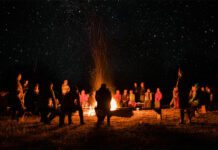Small group ministry is a vital part of church life. It helps a congregation to grow in spiritual maturity and Christian friendship. Even beyond the personal value, churches are discovering that small groups add to their ability to accomplish another ministry goal: serving the poor and needy and building credibility in the community. Many churches are adding an expectation of missions, outreach and service to their existing small group ministry in order to infuse service into the culture of the church and help people become agents of God’s grace to others.
Small Groups, Huge Impact
Out of the 4,000 in attendance each weekend at Fellowship Bible Church North (fbcnorth.org) in Plano, Texas, more than 1,800 are also involved in a small group during the week. “Our small groups are the primary place where life happens at Fellowship. It is where three of the five core functions of our church take place: connect, grow, and share,” says Glen Brechner, adult ministries pastor.
The church had a strong small group ministry for a number of years, so when leadership decided to greatly expand serving in the community, the discussion eventually came around to integrating the small group ministry with community service—but not at first. According to Brechner, the church tried a number of strategies, not seeing the synergy between community service and the small group dynamic. Fellowship planned and participated in all-church community service events—where hundreds of members served schools and community agencies on a weekend. They also preached an ongoing externally focused vision from the pulpit, but the church’s leadership admits they repeatedly lost traction when it came to living into the vision—until they looked at their small groups.
“While we thought our groups were healthy, we soon realized that truly healthy groups have a purpose beyond themselves. Making a group healthy means getting groups to look out instead of in, to serve instead of consume. While most of our groups had the heart to make a difference, few did,” says Brechner.
Internally Healthy, Externally Focused
So the church intentionally developed a strategy for each of their groups to be internally healthy and externally focused. Brechner explains, “An externally focused group means that, as you experience life together, you build bridges to others so they can journey with you. Being externally focused means that you travel together with your group, as you will not have tunnel vision but will be looking for others to bring on the journey.”
To promote the new concept of small groups serving, the church rewrote their small group leader curriculum, produced a vision-casting DVD and asked each group to add service and outreach volunteer positions to the group structure in addition to the host and the leader.
The church was also clear about their expectation that every small group, called a LifeGroup, serve together. Each group was asked to build one of three “service” bridges over the course of a year.
“One bridge is a relational bridge of connection to someone in their circle of influence that needs Jesus Christ,” Brechner relates. “The second option is to build a community bridge by adopting an agency or school that their group can serve. Finally, they can choose to build a global bridge by connecting with a missionary, people group, culture or country.”
Once a group chose which bridge they wanted to build together, they were expected to actively pursue it at least one out of every four or five times the group met. Each group was asked to serve with one of the church’s 20-30 community partners or develop their own service opportunities.
“Instead of spending an evening in a living room, they’re spending that time in a food pantry or teen shelter serving the community together,” says Brechner.
With 1,800 people in small groups, it makes for a significant service force in Plano, Texas, and the surrounding communities.
Like Fellowship Church, North Coast Church in Vista, Calif., (northcoastchurch.com) has a strong small group culture. “Once a person visits the church, the main message they hear after the Gospel is to join a growth group,” says Casey Yorman, community ministry pastor.
And people at North Coast have gotten the message. Since 1985, North Coast has seen weekly attendance in their small groups equal 80 percent of the weekend attendance. In the fall of 2006, North Coast presented an ambitious goal to their congregation. “As a church, we wanted to average at least one community service project a day for an entire year,” says Yorman. He insisted small groups were key to reaching the goal.
“We asked each small group to do two service projects during the year,” Yorman relates. North Coast has not only met that goal, but exceeded it, completing 387 community service projects by August 2007.
Structuring Groups for Service
“Having passionate and skilled people leading the LifeGroup in a specific area is a huge factor to success,” says Brechner. That’s why each group at Fellowship has not only a leader, but three “champions.”
“The champion is the person who ‘champions’ a core value (connect, grow and share) to the group. They make sure that the group is experiencing this element as a key part of group life,” Brechner says. The job of the leader is then to lead these champions as they lead the entire group.
Fellowship outlines the following job descriptions for the role of each champion:
Connect Champions are responsible for keeping their pulse on the health of the group. Their responsibility is not to meet all the needs of a LifeGroup, but to lead the group in meeting each other’s needs. They also help make new people feel welcomed and connected.
Growth Champions are responsible for the overall spiritual growth of the group. They are the ones asking the questions about how people are growing in their relationship with God. The Growth Champion is aware of the resources available to the group and usually is one who enjoys and shares some of the teaching element of the LifeGoup.
Share Champions are people who desire to lead the LifeGroup in making a difference in the community. They are primarily responsible for coordinating the bridge of each LifeGroup and connecting with the area outreach coordinator on geographic opportunities.
“When a group has all three champions in place, it helps make sure the group has a healthy, well-balanced focus on the things we are all called to do together,” says Brechner. They found this model to be especially effective in engaging small groups with local schools and agencies, as well as meeting immediate needs during a crisis. Fellowship Bible Church North was one of the first responders to the Hurricane Katrina crisis. They were able to wrap care and support around 70 displaced families by pairing them with their 70 small groups.
Overcoming the Challenges
Many externally focused churches engage in the community via partnerships with other community agencies—but these partners don’t always welcome the task of finding ongoing service opportunities for a dozen or more people.
So how does a church leader approach a community agency about serving them through small groups? Yorman says when approaching a community partner, such as a homeless shelter, school, or soup kitchen, he tries to stay in a learning mode.
“When we are learning together, I don’t promise them the world. As a large church, sometimes the agencies get stars in their eyes,” Yorman says.
Some of his rules on engagement with partnering agencies include:
- Have leadership in place. “Don’t start an official partnership without volunteer team leaders that serve as the point people and facilitate the relationship between the nonprofit and the church.”
- Look for consistency. “For us, an official partnership is working with an agency at least three times in nine months.”
- Be honest about resources. “I impress on them that we want to share our most valuable resource: our people.”
Finally, Yorman urges churches and agencies to dream together—and discuss how important small groups are in the faith community culture. “Many agency directors have never even thought about what they could possibly do with 14 people for two hours. Once our partner agencies started to dream a little bit, a lot of them really liked our small groups coming to serve.”
Reaping the Benefits
“Outreach is always the hardest rock to push up the hill for any church, but we’ve learned that if you get your small groups involved, it will not only make a difference in the community, it will develop deeper community within the small groups at your church,” Brechner advises.
Externally focused churches find that there are at least three benefits to small groups serving together: (1) spiritual growth, (2) greater relational connection, and (3) ability to go deeper in their service and meet more difficult needs.
1. Spiritual Growth
Fellowship Bible Church North encourages groups to participate in community service because spiritual growth is not limited to accountability and Bible studies alone. “In many cases, serving together produces better opportunities to grow because our character and attitudes are exposed and tested,” says Brechner.
2. Relational Connection
“Many people will shine while serving in the community who would never shine in a small group setting like dinner and a study,” Brechner explains. This can be especially true for men involved in small groups, North Coast’s Yorman agrees. “The guys in my own small group especially enjoy the service projects. We get to know each other shoulder to shoulder and participate in a common experience we can build on.”
In their book, Men Are Like Waffles, Women are Like Spaghetti (Harvest House), authors Bill and Pam Farrell describe why men might find it easier to connect during a service project than over coffee and Bible study.
“Because men tend to be good with mechanical and spatial activities, they get emotionally attached to building, fixing and chasing things. Yard projects become expressions of his personality. The car becomes his signature…The bottom line with men is: they feel best about themselves when they are solving problems.”
That may be why New Commandment Men’s Ministries, Broomfield, Colo., (newcommandment.org) has experienced so much success in helping churches establish quality men’s small groups. According to New Commandment’s president Herb Reese, “Since January of 2003, we have helped churches develop men’s team ministries to the widowed and single parents. Over the past four years, we have worked with 65 churches in 18 states to develop this ministry. There are now more than 1,400 men donating 28,000 hours of service annually to over 500 widows, single parents and children.” By encouraging men to study and then serve together one Saturday morning a month, New Commandment Men’s Ministries typically sees 10 to 30 percent of all the men in a church become involved in this ministry.
3. Meeting Complex Needs
Serving a community can be a difficult job, especially when the issues are more complex, like homelessness and AIDS. But as Ecclesiastes 4:11 advises, “Two are better than one, because they have a good return for their work.”
North Coast Church had a desire to serve at the local homeless shelter and AIDS house, but individuals were not always eager to sign up and participate. However, when the church began advertising these same opportunities in the context of a small group serving together, the idea was received much differently.
“Some of the more socially intimidating projects are actually flourishing now because people will go places with others that they won’t go to alone,” Yorman says. “The AIDS house or homeless shelter is much easier to visit with friends. Now, some people have volunteered more frequently and passionately, like taking AIDS residents out to a movie.”
Small groups can also make a huge impact on the life of one family. Peter and Judy Archbold, small group leaders for Fellowship, found this to be true. After 20 years of involvement in small groups, they chose to build a bridge of service to someone outside their group.
“At Christmas time, our church provides individuals the opportunity to connect with a family in need through the Plano Assistance Center. I chose an ‘angel’ from the tree—specifically looking for a single mom we could help,” shares Judy.
Instead of simply buying and delivering the gifts, Judy called the family and got to know them. She quickly realized that Tricia and her boys had deeper needs beyond Christmas presents. The small group has rallied around her by taking care of the boys overnight, helping her get a new car, getting her GED, finding her a math tutor and connecting her with a better paying job with benefits.
What has this adventure in serving done for their small group? “We have developed a greater sense of compassion and understanding for the real lives of the working poor, and anytime you join together you get a feeling of satisfaction and blessing,” says Judy. The group’s care for the family has also witnessed to others. “My sister, who is not a churchgoer, has become involved. She has seen how this Life Group works and it’s been an outreach to her as well.”
Alone, the Archbolds may not have been able to support Tricia, but with the help of others, Brechner says, “This group changed the trajectory of this single mom’s life!”
This article is adapted from the Leadership Network resource: “Externally Focused Small Groups, How Churches Are Re-Engineering Their Small Groups for Community Service” by Krista Petty. To read the entire paper or receive additional free resources about externally focused churches, visit leadnet.org.
Krista Petty is an editor, writer and coach for the externally focused church movement. She lives in Johnstown, Colo., with her husband, Steve, and three children. Contact her at krista_petty@msn.com. Copyright © by Outreach magazine. All rights reserved. Used by permission.













